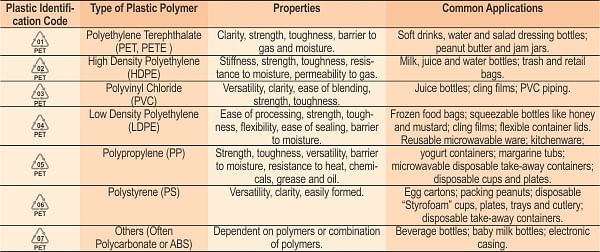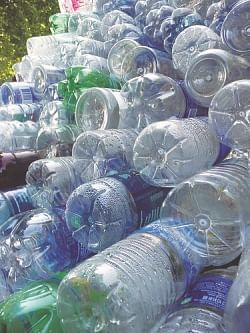| Home - Back Issues - The Team - Contact Us |
 |
| Volume 11 |Issue 19 | May 11, 2012 | |
|
|
Health To Reuse or not to Reuse Shezami Khalil Seventy percent of the human body is water. We drink, on average, two litres a day. In fact, one can last longer without food than without water (3 to 5 days without water is enough to cause death). Given the importance of water in our lives, we should be careful about the various risks associated with water. Being located in a delta, people in Bangladesh are constantly exposed to waterborne diseases. The risk of infections is further enhanced by poor sanitation system and the short supply of sanitary water. The medium where we store our drinking water also has serious repercussions on our health. The culprit here is plastics and their usage as storage containers for drinking water. Sadly, very few people know that plastics can play a significant role in increasing our exposure to waterborne diseases. In addition, some plastics can also release toxins into the drinking water that act as carcinogens. So how does plastic increase our exposure to health hazards? Firstly, from reuse! So if you're thinking of reusing that plastic water bottle - think again. Plastic actually harbours bacterial growth. This growth is enhanced because the bottle traps humidity when it gets close to being empty allowing the bacteria to form colonies in the mouthpiece. Since the bottle is usually not washed carefully, the bacteria seep into the water when reused. Renata Limited's Quality Control Lab carried out a chemical and microbiological analysis on filtered water and filtered water refrigerated in a reused plastic beverage bottle. The water was tested for Free Chlorine (a disinfectant), Microbial Count (a measure of bacteria in CFU/mL or Colony Forming Units per milliliter), Total Coliforms (a group of bacteria found in feces, soil and vegetation) and Fecal Coliforms (presence of the E. coli bacteria found exclusively in feces). The filtered water was safe for drinking as the microbial count is below the acceptable threshold and coliforms are absent. The refrigerated water, which was stored in a reused beverage bottle, did not contain any free chlorine, total coliforms or fecal coliforms but the microbial count indicates that the bacteria level is harmful - although the water was filtered beforehand. The reasons for this could be: * The water was stored in a reused plastic beverage bottle which harbours microbial growth. * Before refrigeration, the bottle might have been washed with tap water which is highly contaminated with bacteria. Other tests were carried out as well (pH, hardness, nitrate, chloride, sulfate, iron, copper and dissolved solid contents) and there was all within acceptable limits. Moreover, all tests were carried out twice to increase accuracy.
Bottom line – do not reuse mineral water and beverage bottles! Here's a little about the chemicals that may be leached from plastic water bottles. Bisphenol A (BPA), a toxic chemical present in most polycarbonate bottles, is responsible for an increased risk of cancer and endocrinological disorders. BPA is linked to breast cancer, uterine cancer, increased risk of miscarriage, decreased testosterone levels, disruption of the thyroid hormone function, expansion of prostate cancer cells and the interference of gender differentiation during brain development. Although the level of BPA leaching from plastic water bottles may be low, experts are still concerned about the cumulative effect of small doses. DEHP (di-2-ethyl hexyl phthalate) is another carcinogen found in plastic bottles. According to The Green Guide, plastic bottles made from PET (plastic # 1) and PVC (plastic # 3) are safe for one-time use only. PVC (plastic # 3) leaches another hormone-disrupting chemical into the liquid when the bottle is reused. PS (plastic # 6) is also known to leach a probable human carcinogen, styrene, into food and drinks. Recent studies have shown that Lexan (plastic # 7) contains chemicals that make it absolutely unsafe for use. So coming back to water – how should you store it? Fortunately, not all plastics are harmful and toxic. There are safer and less toxic plastics like HDPE (plastic # 2), LDPE (plastic # 4) or PP (plastic # 5) and, according to The Green Guide, bottles made from these plastics can be reused. And there are of course non-plastic alternatives such as stainless steel, aluminum and glass. Here's a rundown on the pros and cons of the various water storing options. Reusable Plastics (safety rating: 5/5): HDPE (plastic # 2), LDPE (plastic # 4) and PP (plastic # 5) do not leach chemicals into the liquid. However, these plastics do require a thorough wash with warm water and detergent before reuse. But long term usage is not appealing since these plastics develop stains and odours from repeated use and are prone to breakage if not handled carefully.
Stainless Steel (safety rating: 4/5): these bottles are made from culinary-grade stainless steel and cannot leach as the material is non-reactive. These bottles are also durable, lightweight and come in various sizes, colors and designs. However, the stored water may taste slightly metallic and these bottles do tend to heat quickly in hot weather. Glass (safety rating: 3/4): these bottles are an ideal choice for storing drinking water as they are BPA free, durable and long lasting. Aluminum (safety rating: 1/5): these are often mistaken for stainless steel as they look similar. In reality, aluminum is reactive with acidic liquids and thus needs to need to be lined with an enamel or epoxy layer. But the epoxy layer may contain BPA – which is not good. Moreover, the epoxy layers are susceptible to damage and its effectiveness may be affected if the bottle is dropped. Aluminum bottles usually have narrow neck making it difficult to clean and dry. Although an alternative to non-reusable plastic, it is not the best and needs to be used with caution. The safest plastic is HDPE (plastic # 2); baby bottles from reputable brands are made from this. Do check the plastic number on the bottle before you buy it and make sure to clean it thoroughly before use and reuse. To prevent bacterial growth in baby bottles, the Centre for Disease Control and Prevention recommends the following steps for cleaning: * Place all the components of the baby bottles in a clean bowl containing hot water and baking soda. * Soak them overnight. * Scrub the bottles with a clean bottle brush and rinse them with hot water. * Boil the bottles and its components with a little bit of baking soda for 3 minutes. * Remove the bottles and the components using metal forceps or tongs, dry thoroughly and store in a clean area. We do tend to reuse plastic bottles – but we shouldn't because plastic bottles are safe for one time use only. And always check the grade of plastic before reusing them. Our recommendation is that because local manufacturers do not put any grades on the bottles, it is best not to reuse at all. Store drinking water in glass or stainless steel bottles and wash them thoroughly before reuse. More importantly – always drink filtered water since boiled water is not enough to get rid of all contamination. Happy drinking! Copyright
(R) thedailystar.net 2012 |
 Secondly, there is the risk of chemicals from the plastic leaching into the liquid. A lot of these chemicals are harmful and leaching increases with each subsequent wash. So even if you wash the bottle to prevent bacterial exposure, this does not save you from chemical exposure because the soft walls of the bottle makes it prone to leaching over time.
Secondly, there is the risk of chemicals from the plastic leaching into the liquid. A lot of these chemicals are harmful and leaching increases with each subsequent wash. So even if you wash the bottle to prevent bacterial exposure, this does not save you from chemical exposure because the soft walls of the bottle makes it prone to leaching over time. 
